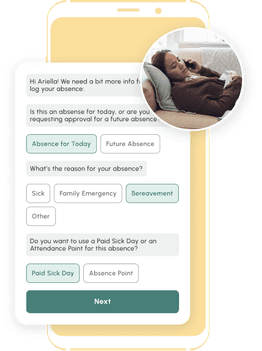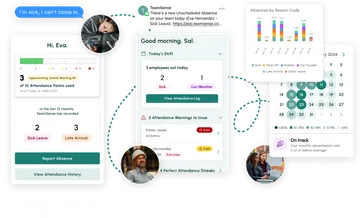Fix the root cause of No-Call No-Show with help from TeamSense
Table of Contents
- TL:DR Download our Text vs. Call-Off Hotline Comparison chart for a quick look at the major differences
- What is an Employee Call-Off Hotline?
- The Advantages & Drawbacks of Standard Employee Call-Off Hotlines
- What to look for when choosing a call-off system
- Comparing Employee Call-Off Call Centers vs. Alternative Solutions
- Employee Call-Off Hotline vs. TeamSense's Text Solution
- Looking Ahead: The Future of Employee Call-Offs
What is an Employee Call-Off Hotline?
An employee call-off hotline is one of the ways the hourly workforce might report an absence due to sickness or an unexpected emergency. It typically involves employees dialing a phone number and speaking to a live agent to explain why they can’t come to work that day.
The Advantages & Drawbacks of Standard Employee Call-Off Hotlines
Using an employee call-off hotline has some advantages: it’s familiar and accessible, and you don’t need an internet connection to call off. But the benefits tend to end there.
If you ask around, the experience of using a call-off hotline is far from ideal.
Here’s why.
Hold times can be long and unpredictable
The average amount of time it takes to call off with a hotline is about 2 minutes, but that can change drastically depending on hold times. We’ve heard in extreme cases, it can take between 30 minutes to 3 hours to call off. For non-native English speakers, it can take even longer to find a multilingual agent. Nobody likes waiting on hold, so if employees are forced to wait too long, they may hang up before they’re able to log the absence, resulting in “no call, no shows.”
No one wants to talk when they’re anxious or stressed
When employees call off, it’s usually because they’re sick, or their kid is sick, or there was a last minute emergency that came up. Needless to say, it’s a stressful time. Waiting on hold and then explaining their absence to an agent is the last thing your employees want to do.
Listen to Devin Frosheiser, Procurement Manager at Yanfeng, talk about the emotional complexity that comes with calling off from work in this 3-minute clip below.
Supervisors are notified way too late
By the time an absence gets reported and makes its way to supervisors, they’ve already realized they’re short-staffed. Shifts have begun. Managers have called in additional staff. Everyone is now in a reactive mode to cover for the absence and keep operations running.
There’s potential for miscommunication and human error
Because call-offs are recorded manually by an agent, there’s a lot of room for human error. Maybe your employee’s name or site was recorded incorrectly or the wrong absence reason was coded into the timekeeping system. These errors can have costly consequences that can affect an employee’s payroll earnings or cause unions to get involved (think: disputes and grievances).
Costs can fluctuate dramatically each month
Call-off hotlines often price their solutions based on the amount of live agent minutes used. This can make one month look drastically different from the next, making planning and budgeting based on guesswork. If the call-off hotline vendor offers prepaid monthly packages, there’s always a chance that your organization runs out of minutes before the month is over, leaving you scrambling to increase your plan’s minutes.
What to look for when choosing a call-off system
Today’s manufacturing workforces use one (or a mix) of several call-off methods: voice-based hotlines, mobile apps, and text message solutions.
When it comes to evaluating and selecting the right one for your manufacturing or logistics workforce, there are some key considerations to keep in mind, like user experience, adoption, and cost. Here’s a look at how the top three call-off methods stack up.
Comparing Employee Call-Off Call Centers vs. Alternative Solutions
Adoption and user experience
Apps: App-based call-off solutions promise a lot. But for manufacturing workforces, apps are often met with a high level of skepticism and hesitancy. Why? Because employees worry that the employee attendance app will let employers overreach with surveillance and invade their privacy. This can make adoption a challenge, which means you’ll potentially have to manage more than one call-off process.
Read our take on employee attendance apps in the blog post below.
Employee Call-Off Hotlines: Call-off hotlines have been used for years. But only because there hasn’t been a better alternative (until now). While it may seem simple to call off by phone, the truth is, every second that goes by waiting on hold, talking to an operator, or manually logging the absence is valuable time that’s lost forever. Your supervisors should know about absences in real-time so they can manpower plan accordingly and prevent ripple effects that impact production. Long hold times can cause hourly employees to hang up out of frustration, so their absence never gets reported despite their best efforts to do so.
Text-Based Solutions: Text message solutions like TeamSense shine when it comes to user experience and adoption. Everyone has a mobile phone these days and knows how to text so solutions like these usually get higher adoption (sometimes up to 100%) from manufacturing workforces. The process to call off takes 45 seconds, and supervisors and HR are notified right away. No game of telephone to track an absence and let the appropriate people know. Plus, user experience.
Cost
Employee Call-Off Hotline: As we mentioned earlier, hotlines are usually priced by usage, so costs can be unpredictable. You may have low usage months or really high usage months, like during the winter when people tend to get sick more often. Aside from these direct costs, call-off hotlines also come with invisible, indirect costs from poor user experiences, like employees waiting on hold or manually logging data into timekeeping systems.
Apps: Apps require a financial and time investment for training and onboarding, not to mention lots of employee education to quell any security fears and get buy-in. The payoff can be significant, with potential gains in data accuracy and operational insights. However, the initial hurdles of adoption and ongoing maintenance can't be overlooked.
Text-Based Solutions: The appeal here is in the ease of implementation and use, leading to high adoption rates and minimal resistance from the workforce. The costs are upfront and predictable, with a pricing model that scales with your business. The return on investment extends beyond dollars, improving employee satisfaction and operational efficiency.
Employee Call-Off Hotline vs. TeamSense's Text Solution
The User Experience: Hotline Calls vs. Text Messages
The user experience of using a call-off hotline isn’t ideal. Hourly employees aren’t too thrilled about long wait times and the need to speak to a human, and the risk of miscommunication and incorrect data entry gives HR managers and leaders a lot of anxiety.
Just being able to text in is going to be a huge game changer for a lot of our employees. A lot of people don't like to pick up the phone and have a 4 minute conversation with someone just to report an absence. And from the admin side that data looks so much nicer than our previous system.


Laura Simon
Human Resources Director, Friendship Village
With TeamSense, employees call off with a simple text message. They immediately see how many absences they’ve accumulated so they can make an informed decision on whether or not they absolutely need to call off that day. If they do, they can easily select an absence reason. No miscommunication or transcription errors.

No one wants to talk to their boss or a 1-800 stranger to call off. Text changes everything - Reducing No Call No Shows.

Operational Benefits of Modern Call-off Systems
Modern, text-based call-off systems like TeamSense not only provide a better user experience for hourly employees and HR, your operations team also will thank you for implementing it.
Here’s why.
TeamSense can reduce absenteeism and “no call, no shows”: Hotlines don’t give employees visibility into their past attendance history or their points balances. With TeamSense, employees see their current attendance info before they submit their absence request, allowing them to think twice about avoidable call-offs.
TeamSense can help supervisors start shifts on time: Instant call-off notifications mean supervisors know who’s going to be in or out for the day as soon as possible. This gives them time to proactively allocate resources to avoid any delays.
We run 24x7 operations...Getting that information on who's here, who's not going to be here, and who's going to get here late factors into how we plan to keep the lines running.

Tim Carracher
Sr. Manager, HRIS, The AZEK Company
TeamSense can reduce operational costs: Unscheduled absences cost manufacturing operations about $3,600 per hourly employee per year in both direct and indirect costs. When you reduce absenteeism with a solution like TeamSense, you spend less on direct costs from overtime and overstaffing, and minimize indirect costs from late startups, work stoppages, hiring replacement workers, and attendance paperwork.
Protecting Employee Data
When an employee calls off with a live agent, that employee’s sensitive data is in the hands of another person. Who knows where that information could end up?
When sensitive call-off information is reported in TeamSense, the system’s user roles and permissions make sure that only those with a need to know can see that information. And of course, when compared to an employee attendance app, TeamSense presents a far smaller attack surface for cyber criminals to access the system and see that information, than does an employee attendance app with hundreds of endpoints on personal devices.
Looking Ahead: The Future of Employee Call-Offs
It’s no surprise that the manufacturing industry has experienced a tight labor market for quite some time, meaning every employee you hire and onboard is critical to the success of your company. Engaging and retaining them means being thoughtful about their needs and providing them with a great employee experience and helpful tools.
In this day and age, those tools are text-based—not hotlines.
TeamSense works with leading manufacturers and logistics companies like The Pella Corporation, The AZEK Company, HelloFresh, and DHL to modernize their absence management processes and actually reduce absenteeism.


